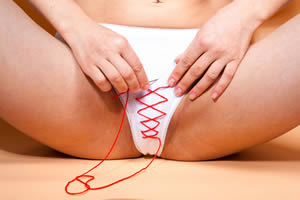Alphabetical Index of Articles on Women's Sexual, Pelvic Floor, and Reproductive Health
Heather Jeffcoat Featured Guest on the Girl Boner Podcast with August McLaughlin

Heather Jeffcoat was once again the featured guest on the hugely popular podcast Girl Boner Radio with August McLaughlin! In this episode they discuss the pelvic floor, painful sex, and physical therapy after gender affirming surgery.
Insider: 7 Reasons Why Your Vagina May Feel Too Tight
 Insider journalist Erin Heger penned this great article about why your vagina may feel too tight, and what to do about it. She reached out to me for my advice, and here is a brief synopsis of the article, along with a link to the full article below.
Insider journalist Erin Heger penned this great article about why your vagina may feel too tight, and what to do about it. She reached out to me for my advice, and here is a brief synopsis of the article, along with a link to the full article below.
Heather Jeffcoat, DPT7 reasons why your vagina may feel too tight, and what you can do about it
Treatment for a vagina that feels tight may include pelvic floor physical therapy, hormone replacement therapy, or estrogen cream.
A vagina that feels tight can make it painful to insert anything from a tampon to a penis. Childbirth, yeast infections, and STIs are common causes of a tight vagina. Other causes include medical conditions like vaginismus, endometriosis, and menopause.
There are many different reasons why your vagina may feel too tight, resulting in pain while inserting a tampon or during sex. In fact, an estimated 75% of women experience pain during intercourse at some point in their lives.
Testimonial by Amanda W.
Heather's unique physical therapy program literally changed my life! After years of struggling with vaginismus, a condition that made it impossible for me to have intercourse and very difficult to use tampons without pain, a gynecologist referred me to Heather. I was nervous for my first appointment, but Heather's professional and friendly demeanor put me at ease. She did a great job explaining each technique she was using to help my muscles relax. Heather uses a combination of internal and external stretches and exercises to relax the pelvic floor and build muscle strength. Her specially developed home program helped me quickly recover from an issue that seemed insurmountable before meeting Heather. She was optimistic about my progress and incredibly encouraging. Less than 6 months after my first session, I was able to have pain-free sex for the first time in my life! If you are suffering from vaginismus or any other pelvic floor issues, I highly recommend making an appointment with Heather and reading her book!
-- Amanda W., 2/15/16 via Yelp!Testimonial by M.N., age 28
A personal journey and testimonial from one of my patients:
I was diagnosed with vaginismus 4 years ago. I never heard of such medical condition until after I got married. At first my husband and I didn't know what to do, we didn't know what the issues were or how to overcome it. Being born and raised in Armenia and being Christian I wasn't that open about talking to sex with others and so it wasn't easy to seek help. But eventually I went to an Ob-Gyn and luckily she knew about the medical condition (not many doctors know). She referred me to a physical therapist and I couldn't believe it and thought it's something I can handle myself. I ordered a kit from vaginismus.com and started practicing with dilators. There was some small progress but wasn't much helpful.
The IRAS Method

Instruction in The IRAS Method is currently only available for individual instruction to patients. Qualified health care practitioners can be instructed in a group or individual setting, in your office or ours.
The IRAS Method is a unique combination of physical therapy, massage, lymphatic drainage and neuromuscular techniques optimized to provide the quickest recovery of pelvic floor muscle spasm, hypertonicity and/or muscle overactivity. It is a proven system to help with common painful sex, bladder and bowel diagnoses.
Vaginismus Recovery - Diagnoses and Treatments

Vaginismus Recovery is Possible
Is it painful to insert a tampon, get through a gynecological pelvic exam, or engage in intercourse? Have you always just thought maybe it’s just supposed to hurt and began to shy away from it all? You’re not alone. There are many women who have felt and thought the same things. What you are feeling is real and the culprit may be a condition called Vaginismus.
What is Vaginismus?
The definition of Vaginismus has been debated over the years and was first introduced into the Diagnostic and Statistical Manual of Mental Disorders (DSM), Third Edition in 1980. It was defined as a “recurrent or persistent involuntary spasm of the musculature of the outer third of the vagina that interferes with sexual intercourse”.1 And now in the DSM, Fifth Edition categorized as a disorder in which any form of vaginal penetration or insertion such as tampons, a digit, gynecological exams, vaginal dilators and intercourse is painful or impossible. Women have described it as “hitting a wall”. This disorder has been put under the umbrella of genito-pelvic pain/penetration disorder (GPPPD) in conjunction with dyspareunia (“recurrent or persistent genital pain associated with sexual intercourse”).2
Yahoo! Life | Why is Having Sex and Inserting Tampons Painful for Some?
 Yahoo! Life looks to answer the question "Why is sex and inserting tampons painful?" in this article penned by Jocelyn Solis-Moreira. When Jocelyn reached out to me for my expertise I was of course glad to offer some insights. Here is my take on the subject, with a link to the original article at the end.
Yahoo! Life looks to answer the question "Why is sex and inserting tampons painful?" in this article penned by Jocelyn Solis-Moreira. When Jocelyn reached out to me for my expertise I was of course glad to offer some insights. Here is my take on the subject, with a link to the original article at the end.
Heather Jeffcoat, DPTWhy is having sex and inserting tampons painful for some?
Vaginismus explained
Vaginismus is one of our main areas of focus here at Femina Physical Therapy. Since the founding of Fusion Wellness and Femina PT we have seen great strides being made in the acceptance of a vaginismus diagnosis as something that is not only real, but treatable. So it's good to see a major internet presence like Yahoo! taking note of the subject and spreading the news to a wider audience.
The Yahoo! article defines vaginismus as "the involuntary tightening of the vaginal muscles that makes wanted penetration very painful or even impossible", and it then goes into some depth on some well known causes, myths, and treatments. Here are some snippets from the article interspersed with my own thoughts where needed.












